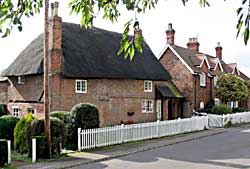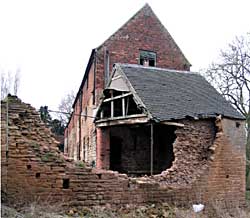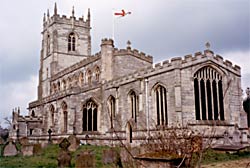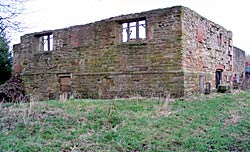
 |
Cottages in Clifton (photograph: A Nicholson, 2004). |
Structural
Standing buildings
An excellent introduction to village buildings in Nottinghamshire:
- Norman Summers, A place to live: the Nottinghamshire heritage, Nottingham: BBC Radio Nottingham/University of Nottingham, 1975.
The essential reference book for buildings in Nottinghamshire villages:
- Niklaus Pevsner, Buildings of Britain: Nottinghamshire, Harmondsworth: Penguin (2nd Edition edited by Elizabeth Williamson), 1978
A good selection of surviving timber-framed village houses and barns is discussed and illustrated in
- Jason Mordan, Timber-frame buildings of Nottinghamshire, West Bridgford: Nottinghamshire County Council, 2005
Researchers should also consult the Historic Buildings Record based with the Heritage Team of Nottinghamshire County Council for detailed information on individual buildings:
Cottages and houses
Maurice Barley’s books on the development of English houses include examples from Nottinghamshire:
- M W Barley, Houses and history, Faber, 1986
- M W Barley, The English farmhouse and cottage, Routledge and Keegan Paul, 1961
- M W Barley, Farmhouses and cottages in Lincolnshire and Nottinghamshire, University of Nottingham M.A. Thesis, 1952.
Farm houses and farm outbuildings
 |
Semi-derelict 17th/18th/19th century outbuildings at Town End Farm, Nuthall (photograph: A Nicholson, 2004). |
The red brick and orange pantiled farm house with its outbuildings is a distinctive feature of the Nottinghamshire rural landscape. The earliest surviving farm complex is at Kneesall and dates from c.1700 and there are also many fine 18th and 19th century examples around the county.
Useful general introductions to the development of farm buildings:
- Nigel Harvey, A history of farm buildings in England and Wales, David and Charles, 1984
- J E C Peters, Discovering traditional farm buildings, Shire Publications, 1981
See the following articles for information on dating farm buildings:
- Ibbotson, P. J. ‘Dating farm buildings, Nottinghamshire Countryside (in Nottinghamshire Topic), August 1980, 12-13
- Severn, J. A. ‘The pleasures and problems of farm buildings, East Midlands Archaeology, 3, 1988, 29-33
A detailed study of an early farm complex:
- Summers, N. ‘Old Hall Farm, Kneesall’, Transactions of the Thoroton Society, 75 1973, 17-25
Dovecotes, windmills and pinfolds:
- Baker, P.H.J. and Wailes, R. 'The Windmills of Derbyshire, Leicestershire and Nottinghamshire', Trans. of the Newcomen Soc., 33 (1960-1961), 113-128; 34 (1961-1962), 89-104.
- Beaumont, G. 'Dovecotes', Heritage: The Nottinghamshire Countryside Newsletter (Spring 1975), 6-8
- Severn, J.A. Dovecotes of Nottinghamshire (Cromwell Press, 1986).
- Morley, D.S. 'Windmills in Nottinghamshire', Nottinghamshire Industrial Archaeology Society Journal, 20, 1 (1995), 4-10; 20, 2 (1995), 1-6; 21, 1 (1996), 5-12; 21, 2 (1996), 7-12; 22, 1 (1997), 1-11. Continuing.
- Shaw, T. Windmills in Nottinghamshire: A Historical Account of Existing Mills and Mill Remains (Nottinghamshire County Council, Planning & Economic Development, 1995). Beaumont, G. 'Village Pinfolds', Heritage: The Nottinghamshire Countryside Newsletter (Summer 1975), 4-5.
- Lyth, P. The Pinfolds of Nottinghamshire (Nottinghamshire County Council, Planning & Economic Development, 1992).
- Lyth, P. 'Pounds and Pinfolds of Nottinghamshire', Nottinghamshire Countryside (in Nottinghamshire Topic) (April 1990), 78-79.
- 'Nottinghamshire Windmills', Heritage: The Nottinghamshire Countryside Newsletter (Summer 1974), 6-9.
Churches
 |
East Markham parish church (photograph: A Nicholson, 1982). |
Nottinghamshire has a good examples of all periods of church building: the severe early Norman interior of Blyth; the magnificent late medieval perpendicular architecture of East Markham; the classical simplicity of Ossington; the impressive Victorian churches attached to Thoresby Hall and (the now demolished) Clumber House. The architecture of the county’s village churches is summarised in
- Niklaus Pevsner, Buildings of England: Nottinghamshire, (Second edition), Penguin, 1979.
There is also a useful overview with selected examples from the main periods of church architecture:
- Peter Billson, Churches in Nottinghamshire, Nottinghamshire County Council, 1993
An informative and well illustrated booklet describing the most significant churches around Nottingham:
- Keith Train, Train on churches: a study of fifty-four churches within reach of Nottingham, BBC Radio Nottingham, 1981
Histories of many parish churches have been published over the years: copies of these are often held by the Local Studies section of public libraries. Regular excursions by the Thoroton Society were made in the early 20th century to churches around the county. The papers read during the visits were subsequently published in the Transactions of the Thoroton Society. See the index to the transactions for details:
- Lawrence Craik, The Thoroton Society of Nottinghamshire. Centenary Index to the Transactions, Record Series and Excavation Section, 1897-1997, 1998
Many of these generously illustrated papers (enhanced with modern photographs) are available on the Nottinghamshire History website:
Excellent photographs of individual Nottinghamshire village churches by Heather Faulkes and others can be seen at:
An important and developing online resource is the Southwell Diocesan Churches Project which aims to provide comprehensive profiles of all parish churches in Nottinghamshire:
Manor houses and halls
 |
The remains of the late medieval Wansley Hall, near Selston (photo: A Nicholson, 2006). |
The surviving Medieval manor houses in the county (e.g. Strelley Hall, Old Hall Farm, Linby, Skegby manor house, Wansley Hall, Manor Farm at Little Carlton) are discussed in:
- Maurice Barley, Nottinghamshire medieval manor houses, Nottingham Medieval Studies, 32, 1988
- M W Bishop and P Billson, Wansley Hall, West Bridgford: Nottinghamshire County Council, Planning and Transportation Department, 1990
Post-medieval manor houses and halls are discussed in “The smaller houses: manor, farmhouse and cottage” chapter of
- Norman Summers, A place to live: the Nottinghamshire heritage, BBC Radio Nottingham/University of Nottingham, 1975
Public houses
The only comprehensive survey of Nottinghamshire village public houses is:
- Gordon Wright and Brian J Curtis, The inns and pubs of Nottinghamshire. The stories behind the names, West Bridgford: Nottinghamshire County Council, 1995
Archaeology
The best preserved deserted village earthworks are at West Burton (south of Gainsborough), Whimpton Moor (adjoining the A57 between Darlton and Dunham-on-Trent), Thorpe in the Glebe (south-east of Wysall), Willoughby (near Norwell) and Langford (north of Newark). The history of Thorpe in the Glebe is outlined and its earthworks described in:
- Alan Cameron, The deserted medieval village of Thorpe-in-the-Glebe, Nottinghamshire, Transactions of the Thoroton Society, 85, 1981
Earthworks of house platforms, toft boundaries and hollow ways are visible in many villages in the county: in Winkburn a hollow way with adjoining house platforms lies south-west of the church and earthworks of a similar nature exist in a field in the centre of West Markham. The Nottinghamshire Village Earthwork Survey undertaken by the Trent & Peak Archaeology Unit in the mid-1990s recorded earthwork features within and around villages; these were subsequently sketch plotted onto extracts from the 1:10,000 Sites and Monuments Record (SMR) basemap. The records can be viewed at the SMR based with the Heritage Team of Nottinghamshire County Council. A summary of the project has been published:
- Keith Challis and Mike Bishop, Village Earthwork Survey in Nottinghamshire 1994-1996, Transactions of the Thoroton Society, 102, 1998
Regrettably, there have been no large scale village excavations in the county. Smaller scale archaeological work (usually in response to planning proposals) is summarised annually in the ‘Archaeology in Nottinghamshire’ section of the Transactions of the Thoroton Society.
Landscape
A useful guide to the evolution of the English countryside is
- Oliver Rackham, The history of the countryside. Weidenfeld & Nicholson, 1995
The enclosure movement of the 18th and 19th centuries had a profound effect on rural Nottinghamshire. Enclosure and its impact on villages and the rural landscape is discussed in
- J D Chambers, Nottinghamshire in the 18th century. A study of life and labour under the squirearchy, Second edition, Frank Cass, 1966
- Chris Weir, The Nottinghamshire heritage, Phillimore: 1991 [Chapter 3, Fields and farms]
Detailed studies of the effect of enclosure on Keyworth and Southwell:
- John Atkins, Bob Hammond and Peter Roper, A village transformed: Keyworth 1750-1850, Keyworth: Keyworth and District Local History Society, 1999
- Philip Lyth (ed.) Farms and fields of Southwell. The enclosures of Cotmoor and Radley, Normanton, Farnsfield, Halam and Edingley, and Easthopre, 1774-1844, Southwell Local History Group/Workers Educational Association East Midland District, 1991
Village landscapes have also changed dramatically since the mid-20th century. European Union-funded ‘prairie farming’ has drastically transformed the rural landscapes in the east of the county and has resulted in the destruction of miles of hedgerows and the clearance of woodland to make way for industrial-scale farm machinery. For an example of the drastic effect this change in agricultural practice has had on the parishes of Eakring and Maplebeck in central Nottinghamshire see:
- Glasson, N L. Agricultural development and landscape changes — Eakring and Maplebeck. East Midland Geographer, 8(7), June 1985.
Splendid aerial views of villages in north Nottinghamshire with their associated landscapes have been published in:
- Malcolm Dolby, North Nottinghamshire from the air, Retford and District Historical and Archaeological Society, 2000